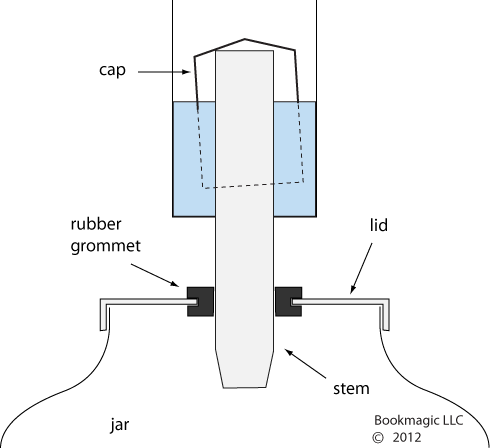Meats and Sausages
Fermenting Glass Jar
Fermenting glass jars with the air-lock installed in the lid are inexpensive and available on the Internet, bur you can make your own even cheaper using basic skills and tools. In open containers a periodic inspection is needed to check for odors and to remove any slime. This requires washing weights, scooping up the slime, discarding bad top leaves or washing/replacing top cloth. With the water channel container those chores are eliminated providing that the water level in the channel is maintained. This requires adding water every few days, depending on the ambient temperature and humidity. There is nothing to add or maintain when a glass jar with an air lock is employed. The water will remain in its small diameter tube for months.
A simple yet practical version of a fermenting crock is a 1 gallon glass (or food grade plastic) jar that has a double bubble air lock attached to the lid. This is the same set up that is used for making wine. Shredded cabbage is tightly packed, weighted and the lid is twisted on. When cabbage is fermenting the bubbles are travelling through the air-lock.
After a while there is no air available to any yeasts or molds that might be inside and there is no white scum on top of the product. The lid is not removed during fermentation and when the bubbles stop, the fermentation is completed.
Professionally made glass jars with the air-lock installed in the lid are inexpensive and available on the Internet.
There are two types of airlocks:
- S-types. The pressure differential is more apparent with an S-type airlock so it is easier and faster to notice fermenting activity. This may be more important for someone brewing beer or wine.
- 3-piece round type. This type is about 2" shorter and much easier to clean.
Both airlocks are manufactured differently: the 3-piece is perfectly round, you may get a S-type that is slightly flat instead of round and won't seal well in the stopper. We use both types and never had an issue. We generally use the S-type for making wine and 3-piece for fermenting vegetables.
Air-lock Principle
The principle remains the same as for S-type air lock or the water channel. Water separates contents of the jar from the outside air. A little cap does the trick; accumulating pressure lifts up the cam and the gas escapes to the outside. There is a little plastic cover with tiny holes on top to prevent insects from getting in.
The advantage of the glass fermenting jar are many:
- Its transparency. The fermenting process can be seen all the time.
- The cost. The jar costs just a fraction of the clay fermenting crocks.
- Size and weight. Clay crocks are huge and heavy.
If someone intends to process 50 pounds of cabbage, the cost of a large and very expensive clay crock is justified, but for processing 10 pounds of cabbage the glass jar is a clear choice. The weakness of the jar is its fragility, the second inconvenience is that during fermentation it should be covered with a dark plastic bag or kept in a dark room.
Note you will notice the red liquid in our airlocks. For demonstration purposes a drop of USDA approved red food color was injected into the water. As long as the airlock is not overfilled, the colored water cannot enter the jar.





















